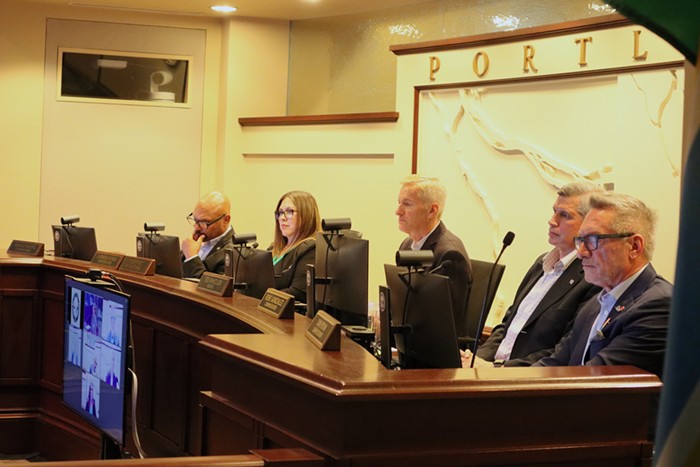A FRIEND OF MINE, a city employee, meets me at the door of the Portland Building on a gray, still morning.
"Have you ever been in here?" she asks.
The aqua-blue exterior tiles loom around us and I'm reminded of the '80s-era YMCA where I learned to swim.
"Just in the lobby," I say, "and up to the part with the exhibit about the building. Never to the top floors."
"Ah," she says, "the top floors are a little different."
We take the elevators up to her office and my friend (who did not want to be identified for this piece) shows me the guts of Portland's eponymous service headquarters. The building is famous for its colorful, gaudy exterior, but as soon as you get past the lobby, all of that falls away.
The actual functional parts of the building, the floors where the water bureau and Portland Parks and Recreation actually spend their time making the city function, are exercises in the worst kind of architectural banality.
The close, beige walls are tight and unusually constricting. I try to extend my arms out from my sides in the hallways. I'm unable to do so, as the space is too narrow. My friend shows me her workspace. It's a desk like any other, and a fairly generic-looking cube farm populates the floor. There is one distinguishing characteristic, though: Unlike other offices in the downtown area with wide windows to let in natural light, the Portland Building's are tiny. The square, dark windows seem even smaller when viewed from the inside.
The aesthetics of the building's exterior are debatable. The inside is aggressively ugly. What's more, the 1982 building needs up to $95 million in repairs to fix systemic problems, most especially leaks, according to an Oregonian article earlier this year. I saw no shortage of drip-catching towels, stained ceilings, and discolored carpets during my tour. One can see why tearing the building down is a perennial topic of conversation.
The Portland Building's failures (both aesthetic and functional) are well known. The architect of the building, Michael Graves, has served as something of a lightning rod for Portlanders' frustration about the structure, and last month Graves (who's also designed numerous handy household items for Target) let fly a storm of his own when he told the Portland Tribune the building's detractors are full of "bullshit," and the problems have been overblown. (I reached out to Graves' representatives several times for this feature, but they did not grant a request for an interview.)
It's easy to see Graves as overambitious, a young architect who attempted to dance and fell on his face. However, focusing on Graves as the whole source of the Portland Building's failure is shortsighted and inaccurate. In reality, myriad issues came into play during the Portland Building's creation, and all of those things, together, ultimately doomed it to ambivalence.
Portland, 1980
Midcentury Portland was nothing like the city that now gets an incessant drip of New York Times travel articles written about it. In the 1950s and '60s, the downtown area was a gray dead zone, not so much an ideal of planning, but more like a textbook example of urban hollowing. The 1972 Downtown Plan began the process of creating the active downtown that Portland enjoys today.
"Downtown Portland was definitely experiencing a renaissance" at that time, says Val Ballestrem, an architectural historian with the Architectural Heritage Center. "You had the bus mall up and running. You had the initial planning for what would become Pioneer Courthouse Square. There was a lot of interest in seeing downtown continue to revitalize."
However, in the midst of the dawning downtown renaissance, the city was quite cognizant of not having much in the way of noteworthy buildings.
"We were lucky to have some really talented architects in the area, but [we didn't have] any iconic, internationally known buildings," says Alexander Craghead, an architectural historian formerly of Portland and now at University of California, Berkeley. "The only one with a real reputation was the Equitable, now known as the Commonwealth Building. That was the first modern skyscraper."
The Commonwealth (it's on SW 6th between Washington and Stark) was a modernist wonder in 1948. Its glass curtain wall, large windows, air conditioning, and use of aluminum were like nothing the world had ever seen at the time. The innovation and success of the new building catapulted Portland architect Pietro Belluschi to international fame in architectural circles. However, by 1980 a curtain wall and air conditioning was not going to attract tourists or serve as a symbol of the city. Portland needed an icon.
"There was certainly a tone that the city was trying to re-formulate itself, to become relevant. We had to play catch-up. That attitude was certainly around when [former Mayor] Neil Goldschmidt came in," says Craghead.
"The Portland Building became part of [revitalizing downtown]," says Ballestrem, "they thought it was progressive and cutting edge."
"It Was About Symbolism"
Portland's best-known collection of government offices was supposed to start a design revolution. In 1980, when it was still only a sketch, the Portland Building started appearing in architectural textbooks as an example of postmodernism—a then-new school of architectural thought.
"The postmodernists thought that architecture wasn't about composition or proportion—it was about meaning. It was about symbolism," says Craghead. "One of the basic ideas was that people react to certain symbolic portions of buildings in certain ways. [For example], a postmodernist would argue that if a person saw a building with columns like a Greek temple, they'd think it was a bank or government office, and that's something wired deep in your psychology."
The main source of the symbols that postmodernists put at the center of their philosophy was, indeed, classical architecture.
"Postmodernists tried to reinterpret classical architecture in a very abstract sort of way," says Ballestrem. "In the early 20th century we had all these classical revival buildings with columns and such. Postmodernism was saying, 'Well, we're not going to do a full-on column, we're going to do an architectural detail that looks sort of like one of those columns, but has a spin.' Graves talked about the Portland Building as being typical tripartite architecture with base, middle, and capital. That goes back forever. It was reinterpreting that with a 20th century mindset."
In 1980, Portland needed a municipal office building. Civic employees worked in rented offices dispersed throughout the city. As part of a comprehensive plan to reinvigorate downtown, the city wanted to build a permanent home for municipal offices. This had the potential to be the one thing Portland was missing: a world-class landmark.
At the same time, adherents to postmodernism had an opportunity to finally make their mark on a major American city. One architect who heard of the project early on was a young postmodernist named Michael Graves. Prior to the Portland Building, Graves had designed a few houses and remodels in the Princeton, New Jersey area, but nothing like a major municipal building. This was his big break.
The Contest
Portland wasn't going to merely hire an architectural firm to design a new building. No, the city decided to hold a contest to decide what would be the newest addition to their up-and-coming downtown. The jurors for this contest were not going to be merely local architects (Portland's own Pietro Belluschi was not invited to take part), but world-class luminaries of building design. Heading up the selection committee was Philip Johnson, a well-respected architect who was something of a mentor to Graves. According to Meredith Clausen—a University of Washington architect who wrote extensively about the Portland Building in the Journal of the Society of Architectural Historians—Johnson was eager to help with the selection, and even waived his consulting fee.
Clausen does not paint Johnson as an unbiased selector. He knew Graves, and was ideologically predisposed to the postmodern style. Clausen goes so far as to state that with "Graves bidding for the project, Johnson's appointment as architect juror rendered the outcome all but given."
Indeed, Johnson called the three entries in the competition "a classic glass box, a doughnut, and a temple." The postmodern design, obviously, was the temple, complete with a goddess, Portlandia, who would keep watch above the entrance. Johnson told the Oregonian, "This will make Portland famous."
Putting a Price on an Icon
By 1980, Neil Goldschmidt, the young, flamboyant mayor who wanted to give Portland an icon, had flown off to join the Carter administration. The zealous politician who had overseen downtown's rebirth was gone. The man now most involved with the project was City Commissioner (and future Mayor) Frank Ivancie, a far stodgier leader, who was more concerned with getting a building done cheaply than making something impressive.
"Some of the city leaders, Ivancie and such, were a little bit conservative on the spending side of things," says Ballestrem. "They wanted a building that was going to be new and pretty and fancy—but at the same time they didn't want to pay for all of the bells and whistles."
With Ivancie involved in the contest, budget became a paramount concern for the entrants. The cost of Portland's new office space was to be 90 percent of market rate for buildings at the time.
Graves, who knew about the project before any of the other entrants, was more familiar with the price constraints. Each of his competitors designed more traditional, modernist office buildings that struggled to fit into the budgetary limitations. Graves, though, designed a dramatically cheaper building that was able to sacrifice expensive elements such as large windows and flowing lobbies. The postmodern design wasn't just new—it was also less expensive than a modernist one.
Graves was awarded 783 points by Johnson and his colleagues. His competitors ranked far behind, with scores of only 663 and 606. The contest was controversial at the time, with many detractors claiming it wasn't a design competition at all, but rather a race to see who could make the cheapest building. Joan Smith, president of the Portland Planning Commission, was quoted by the Oregonian as saying, "I don't think it mattered what the building looked like as long as the bottom line penciled out."
Acrimony, Threats, and Reactions
What happens next is complicated. The city council demanded several changes to Graves' and the runner-up's design. Graves' team alleged this violated procurement regulations for government work. They threatened the city with a lawsuit, as did the runner-up. The two entrants were eventually allowed to submit revised designs to the city, and, despite the saber rattling, no lawsuits were actually filed. The city now had to choose between a standard modernist office and a postmodern temple.
During this second selection process, city council chambers played host to a series of debates about the nature of design, with Graves giving a long, impassioned speech where he pleaded with the city that human beings had "moved [away] from the primary identity of the machine, as it is expressed in buildings," and that "we have an enormous opportunity here to not only say something about city government, but to say something about any building in any city."
Ultimately, many aspects of his design were, in fact, pared down for cost-saving measures, and the cheap building was made even cheaper. Large flowing drapes that would have graced the side of the building were turned into two-dimensional ribbon-like structures on the north and south sides. The exterior would be concrete (rather than stucco), and various small structures on the roof would be struck from the final version. Graves also had the interior design taken away from him. A Portland firm outbid him to do the building's insides.
However, the exterior remained much the same. Portland would finally have its temple.
Legacy
Bart King, the author of An Architectural Guidebook to Portland, is not a fan of the Portland Building.
"Pietro Belluschi, Portland's most significant architect to date, he hated that design," says King. "He called it an 'enlarged jukebox.'" That's not the only thing that Belluschi called it. He also referred to the project as an "oversized, beribboned Christmas package."
In his book, King collects an array of criticism about the structure. Probably the harshest is from Carter Wiseman, who at the time called the building "a rather condescending exercise performed by a sophisticated academic on a culturally average community."
Unfortunately for postmodernism, these critics have not been silenced by history. Unlike, say, stodgy music critics who dismissed the Beatles as a fad, these assessments don't seem particularly wrong in hindsight.
"Within architecture, [postmodernism] is considered to be a failed experiment," says Craghead. "Most of architecture has gone to what's known as late modernism. Postmodernism as an architectural form doesn't really exist anymore. The last examples I can think of are shopping malls from the 1990s. I don't think it offered much that was intellectually deep. It was a very limited way to be, and restricted your ability to design because you could only use certain sets of symbols."
Craghead goes on: "You also had a lot of people who attacked [postmodernism] intellectually. They said it was a shallow idea, and wasn't true. There's nothing in your brain that interprets columns as a public building, or a steeped roof as a house. That was just pop psychology."
Then, of course, there are all the repairs the building needs. It also has a spot on the National Register of Historic Places, making it nearly impossible to tear down.
King, who lacerates the building in his book, would be perfectly fine with getting rid of it completely.
"One could say that it's served its purpose. It put Portland on the map in architectural circles, it gave Michael Graves his reputation, the Portlandia statue gave the city a symbol (sort of).... It gave Portland the postcard images it needed."
Craghead disagrees. Even though the Portland Building is controversial, it is still significant.
"Portland has a history of tearing down buildings and regretting it later," he says. "This is one of the most important buildings that's ever been built in the city. No matter how bad it is, no matter how questionable it is in its taste, no matter how much it has caused problems over the years, if we tear it down... people are going to look back and think we're a bunch of bone-headed idiots."














